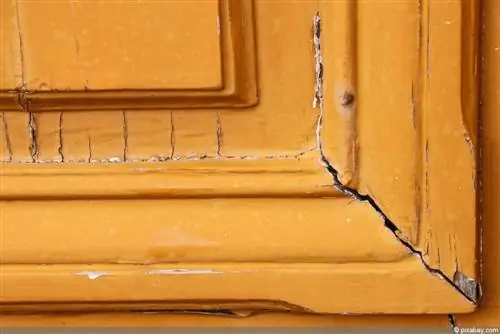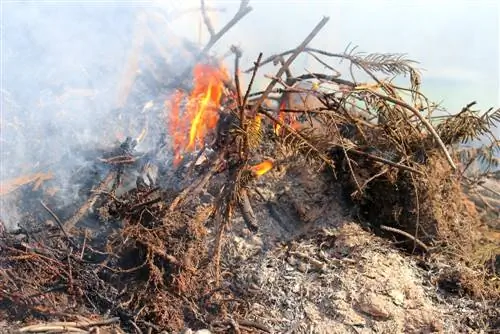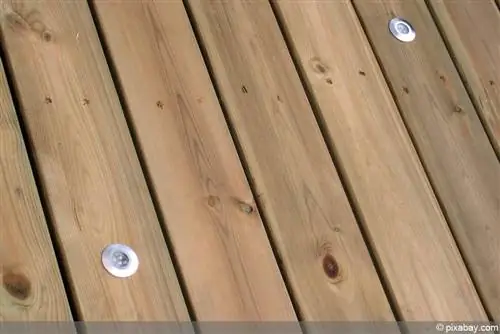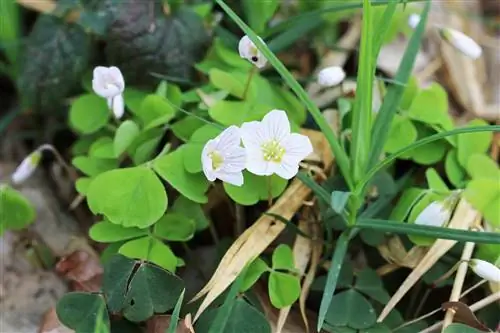- Author admin [email protected].
- Public 2023-12-17 03:39.
- Last modified 2025-06-01 06:48.
If many layers of paint and varnish take away the natural charm of a cabinet, table or door, this can be restored using waste liquor. The condition is that it is real wood. What is meant by waste liquor, which work steps are required and whether the work involved in combination with the costs incurred can be found in the following do-it-yourself instructions.
Waste liquor - definition
Leaching, also known as stripping, is a chemical processing of real wood in which layers of paint and varnish are removed from the wood. When stripping, a distinction is made between alkaline/alkaline and solvent stripping agents. Leaching is part of the alkaline method. Paint strippers/stripping agents usually contain wetting and thickening agents. Thickeners ensure a firmer consistency so that the leaching agent adheres better to the wood when used and does not drip onto the floor when used vertically on doors, for example. The wetting agents determine the effectiveness of the product. Depending on the wetting agent, they lower the surface tension of the paint and varnish solvent. In this way it is possible to get through several layers of varnish and paint.
Alkaline paint strippers include
- Caustic soda and potassium hydroxide
- Ammonia water
- Calcium oxide
- Sodium, calcium and potassium carbonate
- potassium silicate
Possible thickeners can be
- Paste or glue
- Pumicestone
- Talcum
- Sawdust or pebble dust
- Strength
Suitable wetting agents are available to choose from
- Alkylaryl and fatty alcohol sulfonate
- Detergent powder “Rei”
- Soap and soap root extract
- Dishwashing liquid like “Pril”
Tip:
Washing agents are available commercially as a finished product in the form of pastes or as powder for mixing. You save yourself having to search when purchasing the individual components.
Suitable types of wood
Theoretically, all types of real wood are suitable for leaching. For some, this decolorization process causes undesirable discoloration in the wood. Oak is one of these real woods that can get gray or brownish discoloration from leaching due to the high amount of tannins it contains. Thorough rinsing after stripping does not always remove these discolorations. For this reason, you should try out in advance in an invisible area whether the wood is suitable for stripping.
Stripping agent effect
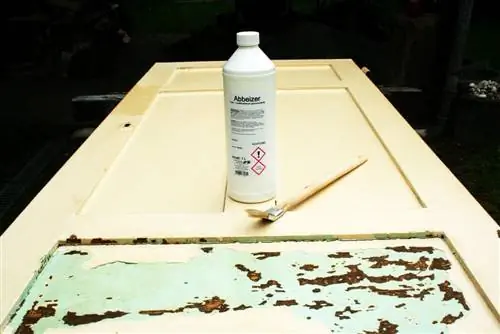
When stripping with alkaline stripping agents, coatings containing fatty acids saponify. The solid dye and varnish is then liquefied and runs off or can be absorbed with an absorbent cloth/sponge. For this reason, leachants only work with oil-based paints and varnishes as well as with alkyd resin varnish, which is often found on antiques or the wood of old houses. A leaching agent has no effect on emulsion paint or acrylic varnish. Solvent-based paint strippers should be used here.
Difference to solvent-based paint strippers
Solvent-based paint strippers contain special organic substances such as gasoline, acetone, methanol or dichloromethane. They “eat through” the layers of paint and varnish so that they detach from the wood and can then be removed. As a rule, gases are released during use, which can cause serious he alth problems, especially when inhaled. For this reason, solvent-based paint strippers should only be used if another type of paint and varnish removal is not possible. Wearing a respiratory mask is recommended when using it.
Difference to paint removal by sanding
Sanding can be an alternative option for paint and varnish removal when present in one coat. The old cupboard from the beginning of the 19th century has experienced many different color trends. In the fifties, vanilla yellow dominated, in the seventies, bright orange was fashionable, in the next decade, dark green dominated the interior design, while black, gray and white with splashes of color and natural wood are currently prevailing. Repainting cabinets and doors is usually done on top of the previous coat, so sanding would remove several layers of paint. This takes a lot of time and effort and a lot of sandpaper because the sanded paint immediately settles into the sandpaper and minimizes the grain. In comparison, alkaline stripping is noticeably more effective, more cost-effective and less labor-intensive.
Make your own caustic soda
In some cases, commercial paint strippers prove to have too little effect. To ensure a sufficient effect, we recommend making your own caustic soda solution. For leaching, you can quickly prepare caustic soda in conjunction with home remedies. It is important to take protective measures such as gloves, eye protection, respiratory protection and an apron, as caustic soda is highly corrosive. Careful handling and a firm, stable surface for preparing lye are required. The advantage of making it yourself is that you can use simple home remedies. The required home remedies can be found in every normal household and usually do not have to be purchased.
Material
- 100 grams of 10 percent caustic soda (sodium hydroxide)
- One liter of water
- Approximately 200 grams of thickener such as starch or wallpaper paste (the amount can be changed depending on the desired consistency)
- If necessary, half a handful of mesh fabric (not absolutely necessary)
- A metal bucket
- A wooden stick for mixing
Tip:
An increased amount/concentration of caustic soda does not increase the effectiveness and does not accelerate the process. Due to the caustic properties and possible white residue on the wood, the stated dosage should not be exceeded.
Manufacturing
- Fill water into the metal bucket (metal because a chemical reaction creates heat in the mixture)
- Add caustic soda evenly and slowly
- Important: the caustic soda must be poured into the water and not the water into the baking soda
- Stir
- Once the lye has cooled down, slowly sprinkle in the thickener while stirring
- Check consistency every now and then
- If a wetting agent is used, this should be stirred in after cooling before the thickener
- Mixture is ready to use when desired consistency is reached
Materials required for leaching
In addition to the stripping agent, the following materials should be available for stripping:
- Spatula or special paint and varnish squeegee
- Slim Woodworking Chisel
- Metal scratch brush
- Plastic or root brush
- Brushes with plastic bristles or plastic sponge
- Old cloths/rags
- Gloves for chemical application
- Mouth and eye protection
The following utensils should also be ready to hand:
- Bowl with clean water, garden hose or pressure washer
- One liter of water with a splash of vinegar essence
Steps for leaching
First step
Distribute the leachant on the colored surfaces using a brush or a plastic sponge. Homemade caustic soda is applied generously. If the moisture on the paint surface decreases, caustic soda should be reapplied until a solution of the paint can be seen. If there is no significant success or if too few areas of color come off, the process can be repeated. It is important to ensure that the entire area is covered again with the leaching agent. In this way, differences in the color of the wood are avoided.
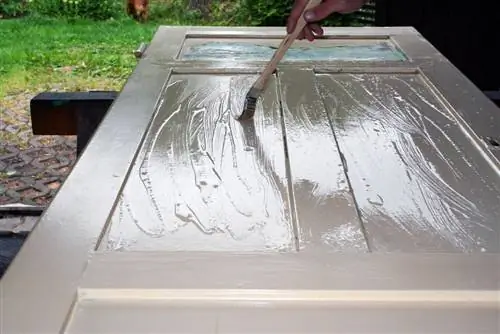
Second step
Depending on the effectiveness of the leaching agent, it takes around five minutes until the paint/varnish comes off. Particles that are still stuck are removed with a remover, a spatula or a wire brush. Paint residue can stubbornly show up, especially in corners. Even after they have completely dried, these can be removed carefully with a sharp chisel or chisel. Since a different color of wood can be hidden underneath, the chisel/chisel method should not be used in too many places. It would then be necessary to leach the entire wooden surface again in order to compensate for the color differences.
Third step
Clean the leached surface generously with water using a root brush. The most effective way to clean with high cleaning power is with a high-pressure cleaner. Care must be taken to ensure that excessive water pressure does not damage the wood. You should avoid using a high-pressure cleaner, especially with soft woods such as spruce or pine. This could cause dents in the wood like a milling machine. If water accumulates, for example in corners, it must be dried continuously.
Fourth step
After cleaning with water, we recommend post-treatment with vinegar essence. Leached surfaces are rubbed off with this. In this way, a further cleaning effect occurs, lye residues are neutralized and the odor caused by the chemical reaction is minimized.
Fifth step
In the last step, the wood must be allowed to dry slowly. Complete drying can take up to 1.5 months. Accelerated drying using artificial heat sources such as a hairdryer should not be used. This could lead to tension in the wood, cause cracks and negatively affect proper functionality such as drawer openings or door closures due to the wood contracting. Glued strips could come loose.
Laugenbad
One waste method is the lye bath. As a rule, this is used by specialist companies who deal with wood that needs to be stripped on a daily basis. In the private sector, the immersion bath is suitable if many smaller objects with many corners need to be stripped. In order to immerse doors or large cabinets in a lye bath, a huge immersion tank would have to be available, which is usually not available in private households. These acquisition costs alone would exceed an acceptable limit.
Costs
Ready-made waste waste and mixed products are available in every hardware store. Caustic soda, among other things, can be purchased for self-production in online DIY shops and specialist cleaning supply stores. They are cheap in price and as follows:
- 250 milliliters of caustic soda - from 2.50 euros
- 500 milliliters of caustic soda - from 4 euros
- 1 liter of caustic soda - from 7 euros
- 2, 5 liters of caustic soda - from 12 euros
- 1 liter of ready-made waste liquor - from 10 euros
- 10 liters of ready-made waste liquor - from 70 euros
- 20 liters of ready-made waste liquor - from 130 euros
Costs for specialist companies
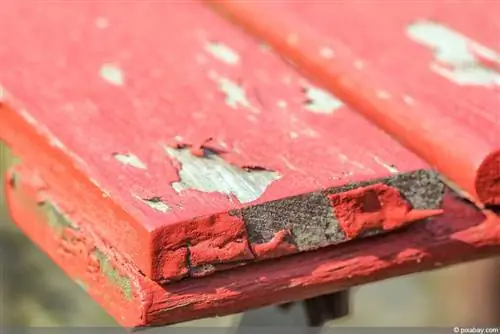
Compared to the costs of DIY leaching, the costs of hiring a specialist company are significantly higher. These vary from company to company, so the following price information is for guidance only.
- Chests of drawers with a maximum width of 80 centimeters - from 130 euros
- Wooden chests with a maximum width of 60 centimeters - from 70 euros
- Tables with a maximum width of one meter - from 120 euros
- Benches with a maximum width of one meter - from 120 euros
- Chairs without armrests from 50 euros - with armrests from 70 euros
- Buffet cabinet with attachment up to 140 centimeters wide - from 220 euros
- Buffet cabinet without attachment up to 140 centimeters wide - from 180 euros
- Room doors up to two square meters in size - from 110 euros
- Front doors up to two square meters in size - from 180 euros
- Shutters - around 50 euros per square meter
- Staircase railings - an average of 10 euros per linear meter

